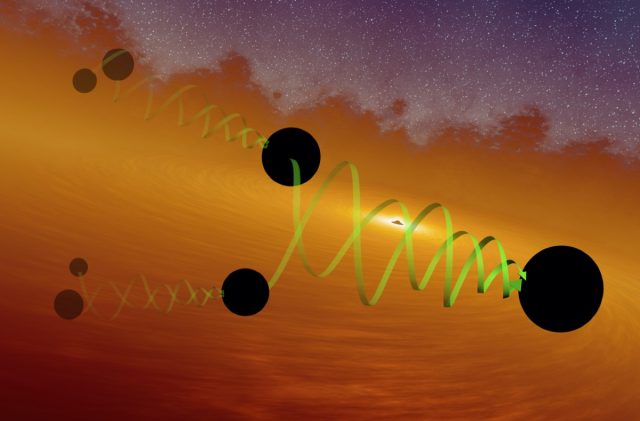J. Samsing/Neils Bohr Institute
In 2019, the LIGO/VIRGO collaboration picked up a gravitational wave signal from a black hole merger that proved to be one for the record books. Dubbed “GW190521,” it was the most massive and most distant yet detected, and it produced the most energetic signal detected thus far, showing up in the data as more of a “bang” than the usual “chirp.”
Furthermore, the new black hole resulting from the merger was about 150 times as heavy as our Sun, making GW190521 the first direct observation of an intermediate-mass black hole. Even weirder, the two black holes that merged were locked in an elliptical (rather than circular) orbit, and their axes of spin were tipped far more than usual compared to those orbits.
Physicists love nothing more than to be presented with an intriguing puzzle that doesn’t immediately seem to fit established theory, and GW190521 gave them just that. New theoretical simulations suggest that all those bizarre aspects can be explained by the presence of a third single black hole horning in on the binary system’s final dance to produce a “chaotic tango,” according to a new paper published in the journal Nature.
As we reported previously, on May 21, 2019, the collaboration’s detectors picked up the telltale signal of a binary black hole merger: four short wiggles lasting less than one-tenth of a second. The shorter the signal, the more massive the black holes that are merging—in this case, 85 and 66 solar masses, respectively. The black holes merged to form a new, even larger black hole of about 142 solar masses, emitting the energetic equivalent of eight solar masses in the process—hence, the powerful signal picked up by the detectors.
What made this event so unusual is that the measurement of 142 solar masses falls smack in the middle of what’s known as a “mass gap” for black holes. Most such objects fall into two groups: stellar-mass black holes (ranging from a few solar masses to tens of solar masses) and supermassive black holes, like the one in the middle of our Milky Way galaxy (ranging from hundreds of thousands to billions of solar masses). The former are the result of massive stars dying in a core-collapse supernova, while the latter’s formation process remains something of a mystery.

LIGO/Caltech/MIT/R. Hurt (IPAC)
The fact that one of the progenitor black holes weighs in at 85 solar masses is also highly unusual since this is at odds with current models of stellar evolution. The kinds of stars that would give rise to black holes between 65 and 135 solar masses would not go supernova and thus would not end up as black holes. Rather, such stars would become unstable and slough off a significant chunk of their mass. Only then would they go supernova—but the result would be a black hole of less than 65 solar masses.